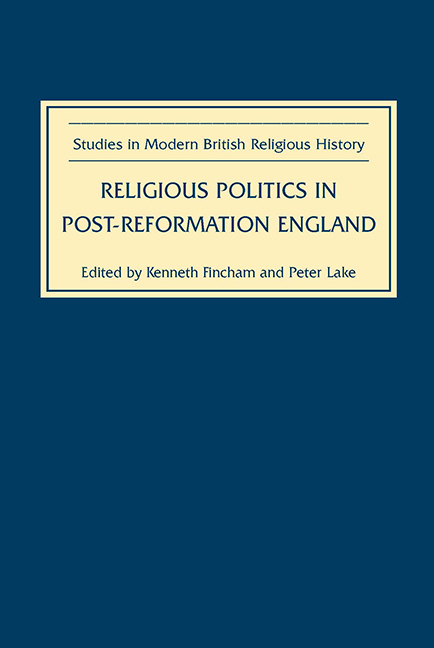Book contents
- Frontmatter
- CONTENTS
- Dedicaton
- Miscellaneous Frontmatter
- Preface
- Abbreviations
- 1 Introduction: Puritanism, Arminianism and Nicholas Tyacke
- 2 Art and Iconoclasm in Early Modern England
- 3 The Latitude of the Church of England
- 4 Joan of Contention: The Myth of the Female Pope in Early Modern England
- 5 Anti-Puritanism: The Structure of a Prejudice
- 6 The Fortunes of English Puritanism: An Elizabethan Perspective
- 7 What's in a Name? Dudley Fenner and the Peculiarities of Puritan Nomenclature
- 8 Puritan Preachers and their Patrons
- 9 New England's Reformation: ‘Wee shall be as a Citty upon a Hill, the Eies of All People are upon Us’
- 10 ‘Anglicanism’ by Stealth: The Career and Influence of John Overall
- 11 Destroyed for doing my Duty: Thomas Felton and the Penal Laws under Elizabeth and James I
- 12 Charles I and Providence
- 13 John Shawe and Edward Bowles: Civic Preachers at Peace and War
- 14 Material Evidence: The Religious Legacy of the Interregnum at St George Tombland, Norwich
- Index
- Tabula Gratulatoria
- Studies in Modern British Religious History
14 - Material Evidence: The Religious Legacy of the Interregnum at St George Tombland, Norwich
Published online by Cambridge University Press: 25 October 2017
- Frontmatter
- CONTENTS
- Dedicaton
- Miscellaneous Frontmatter
- Preface
- Abbreviations
- 1 Introduction: Puritanism, Arminianism and Nicholas Tyacke
- 2 Art and Iconoclasm in Early Modern England
- 3 The Latitude of the Church of England
- 4 Joan of Contention: The Myth of the Female Pope in Early Modern England
- 5 Anti-Puritanism: The Structure of a Prejudice
- 6 The Fortunes of English Puritanism: An Elizabethan Perspective
- 7 What's in a Name? Dudley Fenner and the Peculiarities of Puritan Nomenclature
- 8 Puritan Preachers and their Patrons
- 9 New England's Reformation: ‘Wee shall be as a Citty upon a Hill, the Eies of All People are upon Us’
- 10 ‘Anglicanism’ by Stealth: The Career and Influence of John Overall
- 11 Destroyed for doing my Duty: Thomas Felton and the Penal Laws under Elizabeth and James I
- 12 Charles I and Providence
- 13 John Shawe and Edward Bowles: Civic Preachers at Peace and War
- 14 Material Evidence: The Religious Legacy of the Interregnum at St George Tombland, Norwich
- Index
- Tabula Gratulatoria
- Studies in Modern British Religious History
Summary
A struggle in 1673–80 over whether or not to preserve a gallery built across the east end of the chancel in St George Tombland in Norwich seems an unlikely point of entry into the contested religious politics of post-Restoration England. Yet the gallery at St George's became a focal point for conflicting readings of the recent past and the present priorities of English protestantism, exposing tensions within the parish elite and the diocesan administration of Norwich. The eventual demolition of the gallery and its replacement with a railed and beautified altar in 1680 anticipated that broader shift in parish and diocesan affairs nationally as ‘high’ conformist tories turned on whigs, dissenters, and their Anglican sympathizers in the years 1681–6. Beyond tracing the connections between parish, diocese and nation, the experience of St George Tombland opens up the largely unexplored religious history of Norwich after 1660. Until recently Norwich under Elizabeth and the early Stuarts has been regarded as a citadel of advanced protestantism, but we now know that it was a deeply divided community, and that in the 1630s prominent conformists supported Bishop Wren's drive to impose ceremonialism and curb puritan nonconformity. Here is an opportunity to track some of these divisions into the later seventeenth century. Moreover, the troubles at St George Tombland give an insight into the influence of nonconformists or semi-dissenters within parish affairs. It is well-known that most Presbyterians, and perhaps some Independents, eschewed outright separation from the Restoration Church, serving as parochial officers and attending both Anglican services and conventicles, sometimes out of political and legal prudence, but as often as an expression of loyalty to their parish and to the notion of a unified national Church. What is not fully understood is the impact of these semi-dissenters and their allies on parish government, their relations with conformist neighbours, and their contribution to the organization of parish worship and the style of protestantism professed there, especially in strongholds of dissent such as London, Exeter and Norwich. A study of St George Tombland suggests that their influence was profound, at least in the 1660s and 1670s, aided and abetted by a sympathetic diocesan administration headed by the ex-Presbyterian, Bishop Edward Reynolds.
- Type
- Chapter
- Information
- Religious Politics in Post-Reformation England , pp. 224 - 240Publisher: Boydell & BrewerPrint publication year: 2006

